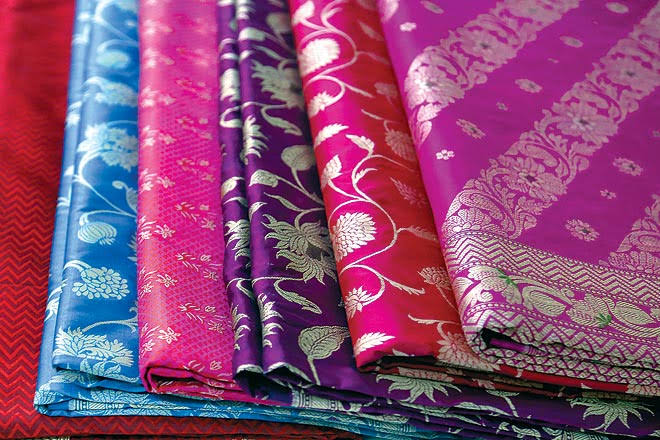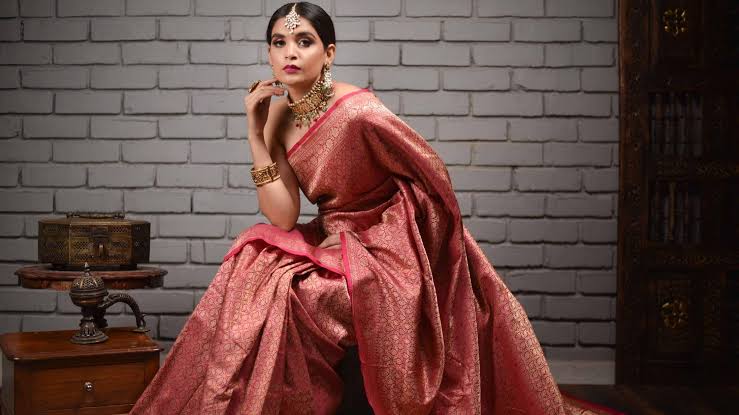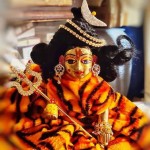Bold yet Beautiful, Vibrant yet Elegant - that’s the true essence of a Banarasi saree, and exactly why women love adorning it in its full glory. Banarasi sarees are traditional sarees originating from the city of Banaras, now known as Varanasi - located in Uttar Pradesh towards the North of India. These sarees are known and widely loved for their intricate designs, fine silk fabric, and gold or silver thread embroidery. With its fine craftsmanship, Banarasi sarees, or the Banarasi fabric, is considered to be one of the finest known fabrics out there! Each piece, from a Banarasi Silk Lehenga, a dupatta to a suit set, is made using a variety of techniques and often worn on the most special occasions like weddings, religious ceremonies, or events. Let’s take you through the better-known art of the Banarasi sarees, a complete guide for beginners.

Historical Background
The tradition of Banarasi sarees dates back to the Mughal era when artisans from Persia migrated to India and brought with them their intricate weaving techniques. Over the centuries, the craft evolved, blending indigenous Indian patterns with Persian motifs, leading to the unique and exquisite designs we see today.
Types of Banarasi Sarees
1. Pure Silk (Katan): Made from pure silk threads, these sarees are known for their durability and sheen.
2. Shattir: Often used for contemporary and budget-friendly Banarasi sarees.
3. Organza (Kora) with Zari and Silk: Characterized by its sheer texture and rich embroidery.
4. Georgette: Lightweight and flowy, these are often chosen for modern and easy-to-wear designs.
Weaving Techniques
Banarasi sarees are woven using a variety of techniques, each contributing to the richness of the fabric:
- Cutwork: A less expensive alternative to the brocade, where the floated thread is cut away.
- Tanchoi: Features small, intricate designs and patterns, often floral, woven with colorful weft silk yarns.
- Jangla: Known for its jangled or intricate wild scrolling designs, often with floral patterns.
Motifs and Patterns
Common motifs include floral patterns (known as Kalga and Bel), intertwining foliate and paisley patterns, and figures with small details. Additionally, the border and pallu (the end piece of the saree) are often heavily decorated with elaborate patterns.
Identifying Authentic Banarasi Sarees
1. Fabric: Genuine Banarasi sarees are made of pure silk and have a certain weight due to the intricate weaving.
2. Zari: Original zari is made of silver threads coated in gold. It can be tested by scratching it slightly; real zari will reveal a reddish silk thread underneath.
3. Weaving: The reverse side of the saree should show floating weft threads, indicating that it is handwoven.

Caring for Your Banarasi Saree
To maintain the beauty and longevity of a Banarasi saree:
- Storage: Store in a cool, dry place, wrapped in a muslin cloth to allow the fabric to breathe.
- Cleaning: Dry clean only to prevent damage to the delicate fabric and zari.
- Maintenance: Refold the saree periodically to avoid permanent creases.
Conclusion
Banarasi sarees are not just garments; they are works of art that carry the rich heritage and craftsmanship of India. Whether for a wedding, a festival, or a special event, a Banarasi saree is a timeless choice that embodies elegance and tradition. Understanding the different types, weaving techniques, and care methods will help you appreciate the beauty and value of these magnificent sarees.











